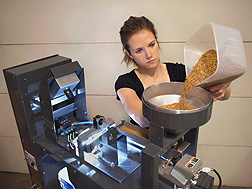Savvy Seed Sorter Gains New Fans
Simple, swift, and comparatively inexpensive, a color-image-based seed sorter is helping plant breeders and others separate the seeds they want from those they don’t—with an impressive degree of accuracy.
Agricultural Research Service agricultural engineer Thomas C. Pearson, based at the agency’s Center for Grain and Animal Health Research in Manhattan, Kansas, developed the sorter in collaboration with National Manufacturing in Lincoln, Nebraska. The company has marketed the device to customers in the United States and abroad since 2010.
In tests, the compact, portable sorter—a simpler and faster version of other machine-vision equipment that Pearson developed in 2009—speedily differentiated kernels of hard red wheat from kernels of hard white winter wheat with 98.6 percent accuracy. Says Pearson, “Breeders cross red and white varieties of these breadmaking wheats to transfer desirable traits from one to another. Test fields are planted with both hard red and hard white wheat. At harvest, the seeds have to be separated.”
The sorter is also skilled at separating yellow from brown flax and barley from durum wheat.
Pearson explains that yellow flax is used somewhat like sesame seeds as a tasty, nut-flavored garnish for breads and other baked goods, while brown flax is harvested for its oil. The sorter was accurate 94 percent of the time in detecting yellow flax seeds from brown ones in Pearson’s tests.
Barley plants can sometimes turn up as unwanted “rogues” or “volunteers” in neighboring test rows of candidate durum wheats. The sorter system detected durum kernels with 93 percent accuracy, Pearson reports.
The device is handling other important tasks, as well. For instance, seed from native grass plants, needed for revegetating publicly owned lands in the western United States, is being sorted to rid it of seeds of unwanted plant species. A major breeder of peas and beans for vegetable farms uses the sorter to remove damaged seeds. Some university plant breeders rely on the machine to discern and discard spotty peas or to reject wheat kernels that show coloration associated with Fusarium head blight, a costly disease of wheat and barley.
The sorter assembly, which measures 3 feet by 1 foot by 3 feet, sits snugly on a wheeled base, making it easy to move from one worksite to another. Unsorted seeds are placed in a vibrating hopper and begin sliding down any of three adjacent chutes. After a seed falls off the end of its chute, a color camera equipped with an image sensor (a complementary metal-oxide semiconductor) snaps an image and sends it, via a circuit board, to a chip for processing.
The chip (a field programmable gate array) uses preprogrammed data to determine whether the seed’s surface texture and red, green, and blue color values more closely match those of an “accept” seed than those of a “reject.” Seeds that appear similar to “rejects” are quickly directed, via a puff of air from an air valve, into the “reject” container, while the desirable seeds fall neatly into the “accept” bucket.
Pearson’s research is documented in peer-reviewed articles published in Applied Engineering in Agriculture, Computers and Electronics in Agriculture, and the Journal of Food Measurement and Characterization.—By Marcia Wood, Agricultural Research Service Information Staff.
This research is part of Quality and Utilization of Agricultural Products, an ARS national program (#306) described at www.nps.ars.usda.gov.
Thomas C. Pearson is with the USDA-ARS Center for Grain and Animal Health Research, 1515 College Ave., Manhattan, KS 66502; (785) 776-2729.
"Savvy Seed Sorter Gains New Fans" was published in the July 2013 issue of Agricultural Research magazine.







